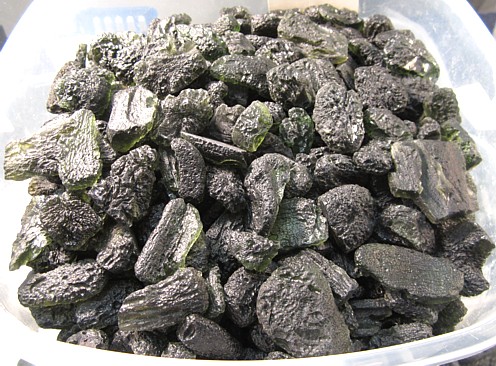
| MOLDAVITE MINERAL FACTS |  |
|
| The Gem and Mineral Collector's Photo Gallery by Nevada Outback |
|
. Moldavite Mineral Facts:
Chemical Formula:
Natural Glass - Meteoric
Colors:
Medium dark green. Hardness: 5.5 Density: 2.32 to 2.36 Cleavage: A glass, not crystalline, so no cleavage observable. Crystallography: Glass - no crystal structure Luster:. Vitreous luster. Normally transparent to translucent. Optics: (Refractive Index): = 1.51 |
|
|
Composition,
Structure and Associated Minerals:
Identification and Diagnostics
Occurrence,
Localities and Origins:
|
Moldavite close up |
|
 Moldavite Selection |
||
|
The most widely accepted opinion that the fragments originate from the fusion of surface soils and rock during the impact of a peculiar kind of meteorite. The material thus ejected from the impact site travels high into the atmosphere, even to the point of spending a short time in space before returning to the earth. These views are accepted for all tektites. The acceptance of this origin for moldavite has lent an added interest to it, and increased its use for jewelry and other applications. The pieces as found are water worn pebbles of various shapes, usually with deeply indented or pitted surfaces, as shown in the accompanying photos. In size they are never larger than one's fist, while they are usually much smaller. They are found in the beds of brooks and in the soil. Regions near Budweis and Trebitsch are especially prolific in the pebbles. It is estimated that the moldavite glass was formed from an impact which happened about 15 million years ago. Glassy tektite pebbles similar to moldavite are found on the island of Billiton, near Java. These are known as billitonite. They are also found in Borneo and several parts of Australia. In these places they are believed to be of the same type of meteoric impact origin. Of the four known different tektite occurrences, only the Bohemian moldavite glass is so far used to any extent in jewelry. Moldavite has been sold under the names of bottle-stone, or water - chrysolite. A natural glass of the same character has been found in water-worn fragments in Ceylon, and has been sold as peridot, which it resembles in color, but is readily distinguished from it by its very different physical properties. The total resource of Moldavite is estimated at 275 tons and there are now four moldavite mines that are in full operation in the Czech Republic. It is projected that inroughly ten years commercial Moldavite mining will come to an end. After this time, there will be virtually no appreciable amount of gem-grade Moldavite left in the ground. High-quality moldavite stones are often used in hand crafted jewelry and thus enters the market away from mainstream jewelry stores, more centered around art and craft style custom jewelry makers. Return to the Mineral Collectors Information Page |
|
|
|
|
||
Please note that the author, Chris Ralph, retains all copyrights to this entire document and it may not be reproduced, quoted or copied without permission.

NEVADA OUTBACK GEMS TURQUOISE AND JEWELRY